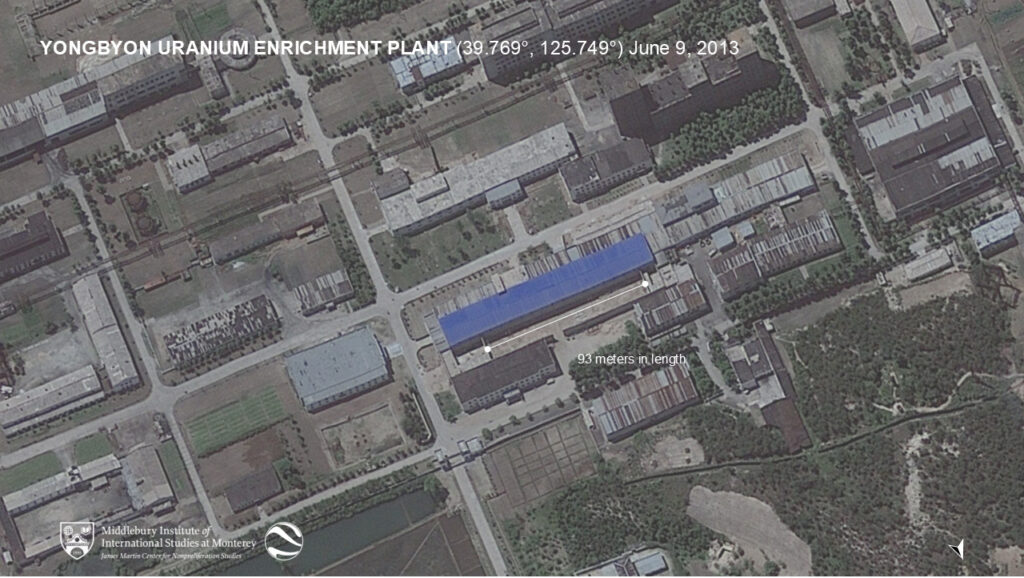June 10, 2025
Sam Lair and Jeffrey Lewis
Posted at armscontrolwonk.com
On Monday, June 9, IAEA Director General Rafael Grossi reported to the IAEA Board of Governors in Vienna that “the Agency is monitoring the construction of a new building at Yongbyon which has dimensions and features similar to the Kangson enrichment plant.”
Although the IAEA did not release images of the facility, Grossi’s description matches a construction site we have been monitoring near Yongbyon. The dimensions and features, in our opinion, are enough to justify the IAEA drawing attention to the facility as a possible enrichment plant.
The building Grossi is referring to is likely located at: 39.786° N, 125.759° E. (See Figure 1: The suspect enrichment facility at Yongbyon.) The building has a large central hall about 95 m in length and 24 m in width surrounded by office and support spaces. An image taken by Planet Labs PBC on April 10, 2025 shows the facility under construction, with a roof covering the central hall where centrifuges would likely to be installed.
The facility does, as Grossi suggests, resemble the enrichment facility near Kangson, first identified in the public domain by researchers from the Middlebury Institute of International Studies at Monterey. A 2002 Image of the Kangson facility under construction shows a similar layout and dimensions. (See Figure 2: The uranium enrichment facility at Kangson, south of Pyongyang.)
In addition to the enrichment facility at Kangson, the first two enrichment halls at Yongbyon also have an internal hall that is 93 m in length – as do the original enrichment halls at Kahuta, in Pakistan. Kahuta’s director, Pakistani scientist AQ Khan provided the DPRK with substantial assistance in setting up the North Korean enrichment program in the 1990s. (See Figures 3-5.)
Khan’s assistance to North Korea was part of a barter agreement in which he provided P2 centrifuges to the DPRK in exchange for Nodong missiles. The P2 centrifuge was a Pakistani-copy of the URENCO G2-type centrifuge. North Korean scientists have claimed their centrifuges have a separative work capacity of about 4 kg SWU per year, a claim that is consistent with the P2, customs data related to components that the DPRK imported in the early 2000s, and the visual appearances of North Korea’s centrifuges today.
The new facility is approximately the same size as the enrichment hall at Kangson, which probably has 3,936 G2-type centrifuges organized into 24 cascades. The facility at Kangson is capable of producing about 70 kilograms of highly enriched uranium per year.
Our estimates of the capacity of the existing Kangson and Yongbyon enrichment plants are based on visual examination of the images released by North Korea during visits to what we assess are the Kangson Uranium Enrichment Plant in September 2024 and the Yongbyon Uranium Enrichment Plant in January 2025.[1]

Figure 6: Images of Kim Jong Un visiting the Kangson Uranium Enrichment Plant (left) and the Yongbyon Uranium Enrichment Plan (right).
As North Korea has expanded its production of enriched uranium by building new facilities, North Korea has packed more centrifuges into a much smaller floorspace. While the original enrichment hall at Kangson allocated about .7 m of floorspace per centrifuge, more recent facilities have dedicated less than that. This is especially true with regard to the spacing between centrifuges across the width of the enrichment hall. The second enrichment hall at Yongbyon, for example, packs 8 cascades across a width of less than 15 m. If the new facility is 24 m in width, then it could hold as many as 32 cascades, although this is a worst case estimate. We present three scenarios for the new facility depending on how tightly North Korea fill the facility, corresponding to the production of 73, 85 and 98 kg of HEU.
Table 1: North Korea’s Known Enrichment Facilities
| Year Completed | No. of Cascades | No. of Machines | kg SWU/a | HEU (kg/a) | |
|---|---|---|---|---|---|
| Kangson | 2003 | 24 | 3,936 | 15,744 | 73 |
| Kangson Annex | 2024 | 12 | 1,968 | 7,872 | 37 |
| Yongbyon A1 | 2010 | 12 | 1,968 | 7,872 | 37 |
| Yongbyon A2 | 2013 | 16 | 2,624 | 10,496 | 49 |
| Yongbyon A3 | 2022 | 12 | 1,968 | 7,872 | 37 |
| Total | 76 | 12,464 | 49,856 | 232 | |
| Yongbyon B | TBD | 24 28 32 |
3,936 4,592 5,248 |
15,744 18,368 20,992 |
73 85 98 |
Table 2: How Tightly Packed Are North Korea’s Centrifuges?
| No. of Cascades | No. of Machines | Total SWU (kg per year) | Floorspace (m3) | Density (m/machine) | Width (m/cascade) | |
|---|---|---|---|---|---|---|
| Kangson | 24 | 3936 | 15744 | 2604 | 0.7 | 2.3 |
| Kangson Annex | 12 | 1968 | 7872 | 1200 | 0.6 | 1.5 |
| Yongbyon Hall 1 | 12 | 1968 | 7872 | 1116 | 0.6 | 2.7 |
| Yongbyon Hall 2 | 16 | 2624 | 10496 | 1302 | 0.5 | 1.8 |
| Yongbyon Annex | 12 | 1968 | 7872 | 1100 | 0.6 | 1.8 |
| Yongbyon B (Scenarios) | 24 28 32 |
3,936 4,592 5,248 |
15,744 18,368 20,992 |
2,280 | 0.6 0.5 0.4 |
2.0 1.7 1.5 |
Notes
[1] See: “Respected Comrade Kim Jong Un Inspects Nuclear Weapons Institute and Production Base for Weapon-grade Nuclear Materials,” Korean Central News Agency, September 13, 2024, https://web.archive.org/web/20240914085813/http://kcna.kp/kp/article/q/69c852101729d6055a771219d3f0a8fd.kcmsf (accessed March 18, 2025) and “Respected Comrade Kim Jong Un Inspects Nuclear-material Production Base and Nuclear Weapons Institute,” KCNA, January 29, 2025, http://kcna.kp/en/article/q/cb8bae4be289a132e31b45035c49ad86.kcmsf (accessed April 3, 2025).




